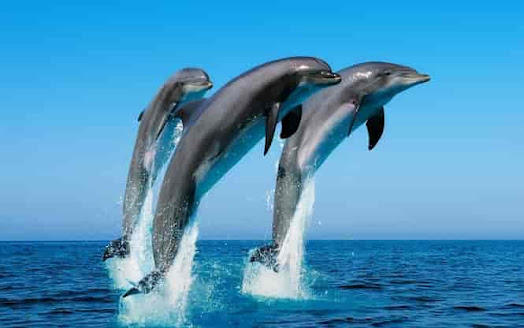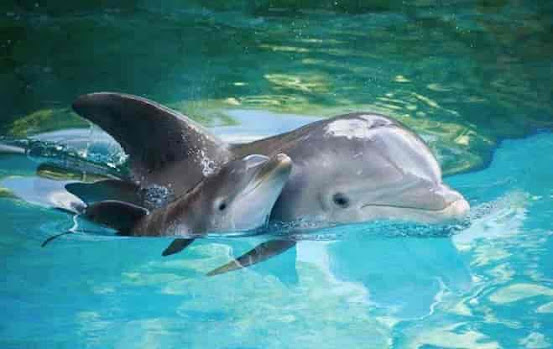Dolphin Facts/ Most Unique and Amazing Facts

Dolphin is an aquatic animal belongs to the mammal family Delphinidae (Oceanic dolphin) and the families Platanistidae, Iniidae, Pontoporiidae. In Delphinidae family has nearly 40 species of dolphins including the killer whale and pilot whale. Scientific name is Delphinus delphis. Whales and dolphins evolved from Pakicetus, a furry mammal that roamed the earth 50 million years ago. The word dolphin is related to the ancient Greek word “womb”. The Greeks called the dolphin “Womb fish”. Wholphin is a best known hybrid, born from a mating of a female common bottlenose dolphin with a male false killer whale. The first known wholphin in the world is a girl wholphin, name Keikaimalu, born 1985. Now she lives at Sea Park Hawaii. Keikaimalu was three times pregnant but her first calf did not survive and the second calf lived only 9 years. Her 3rd calf, name Kawili Kai was born 24 December 2004. She looks like a super-jumbo bottlenose dolphin with darker complexion and incredible whale eyes with 66 teeth , weighing about 602 pounds and length is about11 feet. There are many wholphins existent in the wild but are incredibly rare.
Anatomy of the dolphin
Dolphin has
spindle-shaped body with non-flexible neck. Their limbs modified into flippers
also called pectoral fins and are mostly used for steering. On its back, has a
dorsal fin which acts like the keel on a boat, provides stability to its body.
The two fins called flukes and propels make the dolphin’s tail. The length of
the dolphin is 1.7m and the weight up to 22000 pounds. Killer whale, false
whale and pilot whale are the largest members of the dolphin family and Maui’s
dolphin is the world’s smallest dolphin. They have two small eyes on the both
sides of their heads and they do not have external ear flaps. Their long snout
which is called rostrum is used to probe the ocean floor for hidden fish.
Dolphin has conical-shaped teeth inside the rostrum. Dolphin is a mammal so it
breathes air thus holds their breath when it goes under water. They have
blowholes at the top of their head which they use to breathe when reach the
water surface. They have a layer of fat under their skin, called blubber. The
blubber helps to streamline the dolphin’s body, insulating it into the cold
water. To communicate with each other and echolocate, they use their blowholes
to produce a variety of sounds. Its large fatty forehead is called melon. The
sounds are projected by its melon.
They have awesome eyesight both in and out of water.
The retinas of the dolphin’s eyes contain two kinds of cells- rod cells and
cone cells. Rod cells help them to see even in dim lighted areas. Some marine-life
researchers believe that dolphins are basically colour-blind. They are not able
to enter full sleep mode and sleep with one eye open. Dolphin’s half brain goes
to sleep but other half stays alert and one eye remains working. They stay
half-conscious to lookout for predators and to come up for air every so often.
They are able to see in front of, beside and behind of them because their eyes
are positioned laterally one eye on each side of the head. They have glands on
the eyelids and outer corneal layer which protect the cornea.
Dolphin’s Habitat
Dolphins are found all over the world. They live in
moderate to warm oceans, seas, bays, gulfs, harbours and the areas where the
rivers meet the sea (estuaries). They live close to the shore. Bottlenose
dolphins live in the Pacific Ocean from Japan to Australia and Southern
California to Chile and far west as the Hawaiian Islands. In the Atlantic
Ocean, they are found from Nova Scotia to Patagonia and Norway to the South
Africa. They are also found in Black Sea and Mediterranean Sea.
Dolphins live in groups, which is called “school” or
“pod”.
Diet of Dolphin
As dolphin live along coastal areas, they eat fish,
squid, shrimp, crab octopus, crab, jellyfish etc. which is found on the coastal
bottoms. Their diet is depending on their
species and their habitat. Bottlenose dolphins like to eat Moray fish, Salmon,
mullet, catfish when it is spring and summer months. In winter, they eat
herring and mackerel as the scarcity of salmon.
Adult dolphin eats about 15 to 25 pounds of food each
day. They do not chew their food but swallow the whole. They do not swallow the
salt water when they swallow the food. The salt water is force out of their
mouth when they swallow the food. They obtain the fresh water from their food
such as fish squid etc. which being composed of about 70% of water. The dolphin
has three chambered stomach but few species have two chambers. When they swallow
the food, it stores into the first chamber. In
the second chamber, enzymes and hydrochloric acid are released to complete the
digestion process. The third chamber retains the digested food and passes to
the small intestine.
Dolphins have no sense of smell as they have no
olfactory lobs. They have no taste buds so they have no sense of taste but
prefer to different kinds of fish.
Each day an adult dolphin produces 4L of urine and
about 1.4 kg of faces.
Dolphin baby

Dolphin’s pregnancy periods depend on the species.
Bottlenose dolphin pregnancies are lasting about 12 months. Orcas pregnancies
last 18 months and harbour porpoise last 10 months.
They give birth one baby or calf every 1 to 6 years.
The calf born tail first in most cases. The birth can take about 2 hours. The
length of the calf is 39 to 53 inches and the weight is 22 to 44 pounds. The
new born calf suckles thick milk from its mother.
When the bottlenose dolphins are 6 to 13 years old,
they able to give birth. Every 2 to 3 years, they give birth one calf. The
Orcas give birth every 5 years or more.
After birth, mother dolphin feeds its calf milk for 2
to 3 years. Dolphin milk is very thick and rich so the calf grows quickly. When
the calf is 3 to 4 months, they able to eat a few little fish but still then it
mostly depends on its mother milk. Mother dolphin prepares her youngsters
carefully for independence by teaching it how to find and catch the prey, avoid
danger, interact with other dolphins etc. The calf stays up to 6 years with its
mother.
The other members of the pod defend the calf and they
surround the calf for protecting it from killer whales and the sharks.
Dolphin behaviour

Most dolphins are very playful and active. They are
active mainly in daytime, especially in the morning and afternoon. They like to play with objects and
other dolphins. They can jump up to 4.9m above the water surface and can make
bubble rings.
It has been observed, that dolphins sometimes disturb
birds and animals by dragging them under but do not show intention to eat them.
They establish strong social relationships, assist
injured dolphins, cooperate to feed and survive on their own, and even
voluntarily contact divers and bathers. They
take the injured member to the surface so that it can breathe.
To save energy, swim on the surface of the water, or
jump on the water, since there is less friction in the air. This type of travel
is called porpoising. Not only energy saving, other reasons are orientation,
social performance, fighting, non-verbal communication, entertainment, and
attempts to dislike parasites.
They are good swimmers and can swim up to 18 miles per
hour.
Dolphins have large and highly developed brain so they
are very intelligent and smart animals. They have the largest brain among the
animal kingdom which is weigh about 1600gm.
Studies have shown that dolphins have
self-recognition, cultural education, understanding of symbol-based
communication systems and understanding of abstract concepts - which are
comparable to chimpanzees and other great sizes. They display self-awareness,
problem-solving, empathy, innovation, teaching skills, sadness, happiness, and
curiosity.
Threat to Dolphins

In many parts of Asia, Africa and South America
dolphins hunt occur. Dolphins are killed for food and the fishermen killed the
dolphins as they damage fishing nets. Dolphins
drive hunting activity also a main cause of endangered dolphins. The fishermen
drive the dolphins together with boats towards the beach or bay and close off the route to
the ocean with other boats or nets, and then kill them.
The water pollution is the other cause for the
extinction of dolphins. The waste products oil plastic, heavy metals,
chemicals, organic pollutants in oceans weakening the immune system of the
dolphins and also grow cancerous tumours.
Due to climate change, the birth rate of dolphins in
Shark Bay Western Australia has decreased. Bull shark, dusky shark, tiger shark
and great white shark are the marine enemies of the dolphins. Killer whales
also kill the small species of dolphins.
Some species of dolphins are seriously endangered,
especially Amazon River dolphins, Ganges and Yangtze river dolphins. Sometimes
the dolphins are either injured or die due to collision with boat-propellers.
“Shark culling” is killing of sharks by government
authorities and mainly occur in New South Wales, Queensland, Kwa Zulu-Natal and
Reunion. This type of deliberate killing occurs usually in response to one or
more shark attacks. Since 1962, 50,000 sharks have been killed through this
program. They use shark nets and drum lines by which 1000 dolphins have been
killed in recent year and since 2014, 32 dolphins have been killed in
Queensland and 2310 dolphins in KwaZulu- Natal.


.jpg)














0 Comentarios:
Post a Comment
Please do not use any abusing words or enter any spam links in the comment box